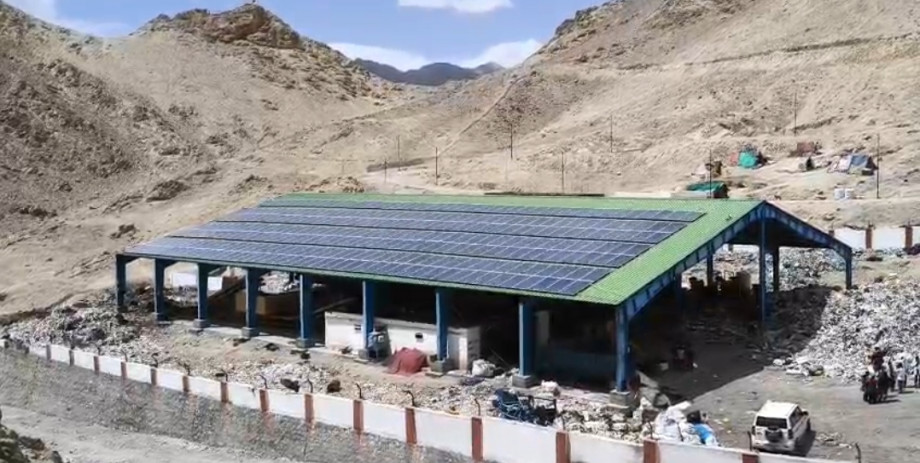Solid waste plant in Leh sets new benchmark in sustainable management The unit handles 30-tonne capacity; composting wet waste, recycling plastics, and running entirely on solar power

Waste management has become an urgent environmental challenge in Ladakh, where the fragile ecosystem is increasingly threatened by unplanned urbanisation and booming tourism. In Leh town alone, approximately 14 to 15 metric tonnes of waste are generated daily—60% of it dry, largely composed of non-biodegradable plastics, and 40% wet.
To address this mounting problem, the Municipal Committee (MC) Leh has been operating a Solid Waste Management Plant at Skampari, La Sermo since 2020. The facility, India’s first fully solar-powered waste processing plant, runs on a 100 kV solar system and employs 12 workers.
At the facility, waste is sorted into recyclable and non-recyclable components. According to plant manager Tsewang Dorjay, all waste is first weighed and unloaded onto a tipping floor, where workers begin manual segregation.
“We separate cardboard, tins, Tetra Packs, plastics, bottles, and clothes before running the recyclables through machines like shredders, crushers, and balers,” Dorjay said. Recyclables are sold to recycling units or reused to create new products. Non-recyclables are directed to landfills, incinerators, or waste-to-energy plants.
With population growth, changing lifestyles, and accelerated development, the volume of waste has surged.
According to Executive Officer Stanzin Rabgais of MC Leh, the waste problem intensified after 1974, when Ladakh opened to tourism. “More packaged goods came in, and the volume of waste grew. Until 2020, we had no scientific method of disposal—waste was simply dumped at the Bomb Guard site near Leh,” he said.
That changed with the launch of the Cleaning of Legacy Waste project in 2020. The Bomb Guard dump was cleared, and the new plant at La Sermo was constructed under the UIDSSMT scheme.
Built at an approximate cost of ₹14 crore, the plant has a daily capacity of 30 metric tonnes. Initially developed by the Public Works Department (PWD), it was first operated by WAPCOS and later managed by 3R Company before being handed over to the MC Leh. The facility has now been running successfully for five years.
As part of Swachh Bharat Mission I, around 3,500 urban households in Leh were provided with green and blue dustbins—for wet (kitchen) waste and dry waste, respectively. Designated waste collection trucks service each category, collecting garbage from homes and businesses on a regular basis.
Rabgais noted that wet waste peaks during the summer months, when hotels and restaurants operate at full capacity. Of the plant’s 30-tonne capacity, 10 tonnes are allocated to wet waste, which is processed via in-vessel composting to produce compost.
“This compost is currently used in municipal gardens and for departmental needs,” he said. “Eventually, we plan to make it available to the public at a nominal cost.”
While the waste plant marks a major step forward, officials stress that it is not a standalone solution. Community awareness and cooperation remain key.
“People must make conscious efforts to reduce waste, segregate at the source, and refrain from dumping or burning garbage in open areas,” Rabgais emphasized. “The system will only work if the public actively participates. A cleaner, greener Ladakh depends on all of us.”





